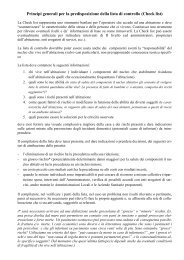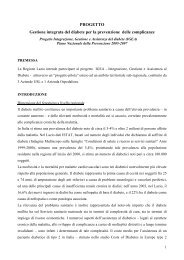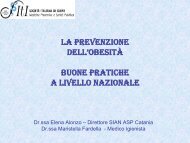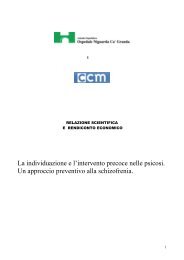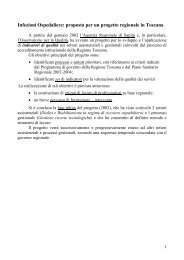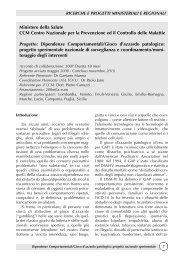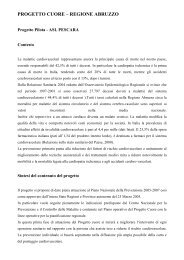Gaining health : analysis of policy development in European ...
Gaining health : analysis of policy development in European ...
Gaining health : analysis of policy development in European ...
You also want an ePaper? Increase the reach of your titles
YUMPU automatically turns print PDFs into web optimized ePapers that Google loves.
The <strong>health</strong> <strong>of</strong> excluded and vulnerable groups is an explicit<br />
component <strong>of</strong> the NPHP. The most important <strong>in</strong>itiative is a<br />
target <strong>health</strong> programme for the Roma population. Despite<br />
some examples <strong>of</strong> good practice, <strong>health</strong> <strong>in</strong>equalities are<br />
still a huge challenge for Hungarian <strong>policy</strong> <strong>development</strong> to<br />
tackle NCD.<br />
5.4. Susta<strong>in</strong><strong>in</strong>g <strong>policy</strong> implementation, monitor<strong>in</strong>g<br />
and revision<br />
Annual progress <strong>in</strong> the NPHP has to be reported to Parliament,<br />
which scrut<strong>in</strong>izes the activities and programmes <strong>in</strong><br />
detail. Compared to the previous situation, this represents<br />
significant progress, stimulat<strong>in</strong>g not only the <strong>development</strong><br />
<strong>of</strong> a comprehensive monitor<strong>in</strong>g and evaluation system on<br />
NCD prevention but also call<strong>in</strong>g, at least once a year, the<br />
attention <strong>of</strong> <strong>policy</strong>-makers to <strong>health</strong> promotion and disease<br />
prevention issues with<strong>in</strong> the framework <strong>of</strong> parliamentary<br />
debate. However, the report does not make a critical <strong>analysis</strong><br />
concern<strong>in</strong>g implementation, the lack <strong>of</strong> resources or the<br />
effectiveness <strong>of</strong> the programmes. In 2005/2006, a lack <strong>of</strong><br />
fund<strong>in</strong>g made impossible the preparation and publication <strong>of</strong><br />
a full pr<strong>in</strong>ted public <strong>health</strong> report.<br />
Each separate activity <strong>of</strong> the yearly public <strong>health</strong> action plan<br />
is monitored <strong>in</strong> technical and f<strong>in</strong>ancial terms, with special<br />
consideration given to some horizontal elements, <strong>in</strong>clud<strong>in</strong>g<br />
impact on equality. This monitor<strong>in</strong>g system is <strong>in</strong>sufficient to<br />
evaluate the quality and effectiveness <strong>of</strong> the programmes.<br />
Some specific monitor<strong>in</strong>g and evaluation activities <strong>of</strong> the<br />
National Institute for Health Development <strong>of</strong>fer deeper<br />
and more detailed evaluation results <strong>in</strong> some specific target<br />
groups.<br />
5.5. Key conclusions<br />
Hungarian policies to tackle NCD have existed for three<br />
decades, with some degree elements <strong>of</strong> cont<strong>in</strong>uity. The<br />
system is <strong>in</strong> place but is not necessarily susta<strong>in</strong>able ow<strong>in</strong>g to<br />
uncerta<strong>in</strong>ty <strong>in</strong> the availability <strong>of</strong> resources. There are some<br />
better developed sub-policies, such as those on tobacco<br />
and nutrition, partly related to the EU <strong>in</strong>tegration process.<br />
There are l<strong>in</strong>ks between the public <strong>health</strong> strategy (as the<br />
ma<strong>in</strong> umbrella <strong>policy</strong>), the risk-related sub-policies and the<br />
topic-oriented larger programmes on, for example, CVD,<br />
cancer and child <strong>health</strong>, but there is little consistency or a<br />
clear coord<strong>in</strong>ation mechanism.<br />
The NPHP has an uncerta<strong>in</strong> susta<strong>in</strong>ability ow<strong>in</strong>g to marg<strong>in</strong>alization<br />
<strong>of</strong> <strong>health</strong> <strong>policy</strong>, limited political commitment and<br />
decl<strong>in</strong><strong>in</strong>g public fund<strong>in</strong>g. At the same time, however, there<br />
is relative stability <strong>in</strong> <strong>in</strong>stitutional human resources and a<br />
number <strong>of</strong> action areas. The <strong>in</strong>vestment <strong>of</strong> the EU structural<br />
funds <strong>in</strong> the field <strong>of</strong> public <strong>health</strong> may create a new<br />
situation <strong>in</strong> the medium term, with long-term challenges for<br />
susta<strong>in</strong>ability.<br />
Equality is a key horizontal dimension <strong>of</strong> any programme<br />
plann<strong>in</strong>g and evaluation <strong>in</strong> public <strong>health</strong>. There are specific<br />
programmes matched to the needs <strong>of</strong> different marg<strong>in</strong>alized<br />
groups, such the Roma population and children from<br />
poor families. However, <strong>in</strong>equality <strong>in</strong> <strong>health</strong> is still <strong>in</strong>creas<strong>in</strong>g<br />
<strong>in</strong> Hungary and the equality aspect <strong>of</strong> the NPHP, despite<br />
expressed concern, is not a success.<br />
Examples <strong>of</strong> good practice appear ma<strong>in</strong>ly <strong>in</strong> communities<br />
and sett<strong>in</strong>gs at regional and local levels. There is a large<br />
number <strong>of</strong> outstand<strong>in</strong>g programmes, successful <strong>in</strong>itiatives<br />
and prime movers <strong>in</strong> the different sett<strong>in</strong>gs, such as workplaces<br />
and schools and at community level. There is also a<br />
limited number <strong>of</strong> recent successful experiences <strong>in</strong> cooperation<br />
with the private sector.<br />
6. References<br />
1. Highlights on <strong>health</strong> <strong>in</strong> Hungary, 2005. Copenhagen,<br />
WHO Regional Office for Europe, 2006 (http://www.<br />
euro.who.<strong>in</strong>t/document/E88736.pdf, accessed 4 June<br />
2009)..<br />
Chapter 4<br />
147<br />
Case studies: <strong>policy</strong> <strong>development</strong> <strong>in</strong> countries for tackl<strong>in</strong>g noncommunicable diseases



